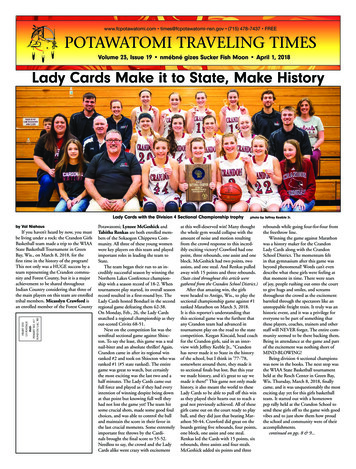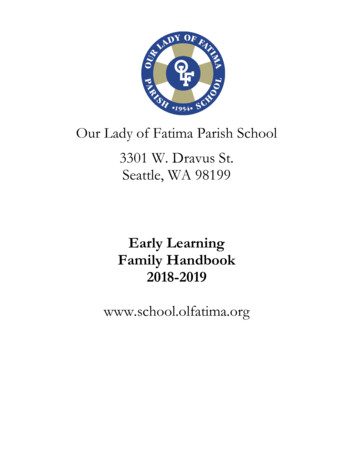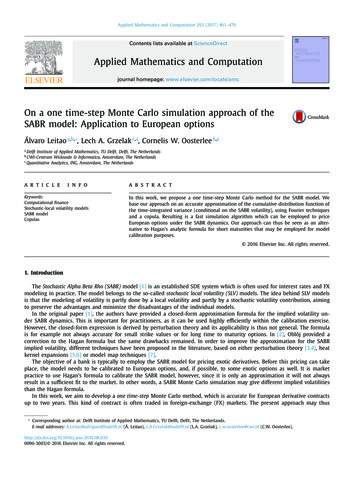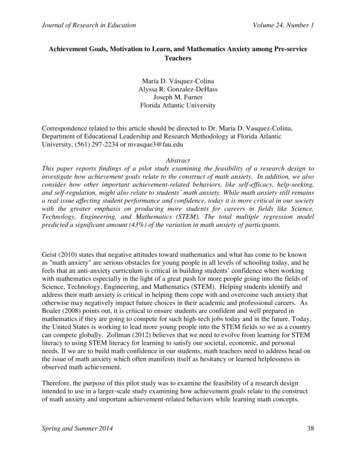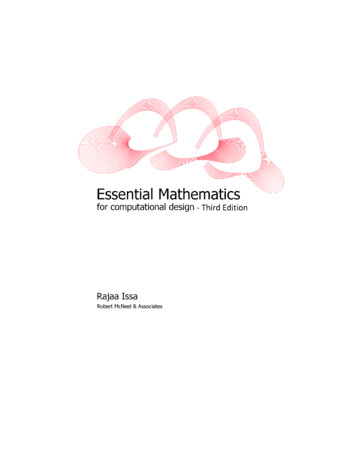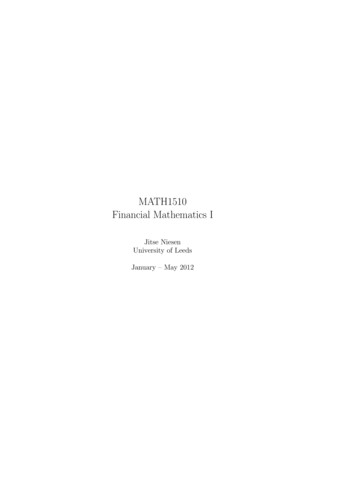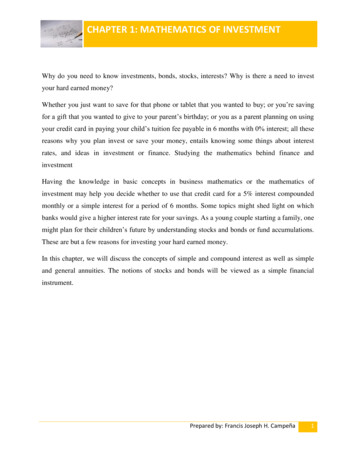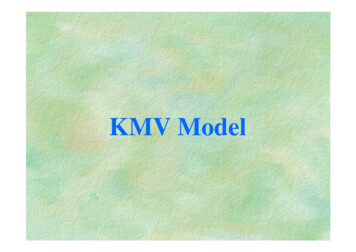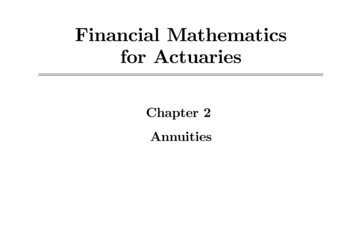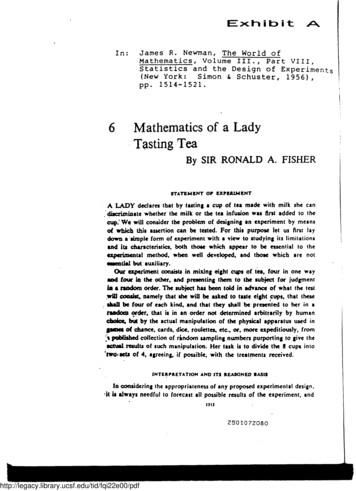
Transcription
E x Vt i b i t AIn : James R . Newman, The World ofMathematics, Volume III ., Part VIII,Statistics and the Design of Experiments(New York : Simon & Schuster, 1956),pp . 1514-1521 .Mathematics of a LadyT4sting TeaBy SIR RONALD A . FISHERSTATEMENT or EXrBR.tAtENTA LADY declares that by tasting a cup of tea made with milk she candiaaimiaate whether the milk or the tea infusion was first added to thecup: We wiil consider the problem of designing an experiment by meansof which this assertion can be tested . For this purpose let us first laydown a airaple fonn of experiment with a view to studying its limitationsand Its chu'acteristics, both those which appear to be essential to thesxperimental method, when well developed, and those which are notss.eatial but auxiliary .Out experiment consists in mixing eight ctws of tea, four in one wayaod tour ia the other, and presentin ; them to the :ublect for judgmentla a raodota order. The subject has been told in advance of what the testwrW oanst , namely that she wiU be asked to taste eight cups, that theset6ati be tour of each kind, and that they shall be presented to her in araadot,n order, that is in an order not determined arbitrarily by humanaboicR, but by the actual manipulation of the physical apparatus used inj.ewt ot dsaace, cards, dice. roulettes, etc., or, nwre expeditiously . trvm0a pnbUslyed collection of Andom sampling numbers purporting to give theactual .raults of such manipulation . Her task is to divide the E cups into twoittas of 4, agreeing, if possible, with the treatments received .INTERTRETATfON ANO ITS REA30JdED aASlsIn oot:siderin the appropriateness of any proposed experimental design, it Is always needful to forecast al1 possible results of the experiment, 2so1a72osa
M.MtwuNtt .l . l.dp rutlmt r. iStlto have decided without ambiguity what interpretation shall be placedupon each one of them . Further, we must know by what argument thisinterpretation is to be sustained . In the present instance we'roay argue asfollows. There are 70 ways of choosing a group of 4 objecta out of s .This may be demonstrated by an argument familiar to atudents of"pernnutatio is and combinations," narnely, that if we were to ctxoose the4 objects in succession we should have successively a, 7, 6, s objects tochoose from, and couid make our succession of choices In i x 7 x 6 x 5,or 1680 ways . 8ut in doing this we have ao( only chosen every poaibksst of 4, but every poasibk ret in erery powibie otdet ; as rd dnce 4 ob)ecucan be arranged in order in 4 X 3 x 2 x 1, or 24 ways , wse eaay tlnd tbenumber of poasibk cttoioes by dividin 1640 by 24 . The result, 70, isesaential to our interpcetatioa ol the expe rimast . At bat the subject canjudge rightly with eYeq cup assd, knowing that 4 are of each kind, thisanxoumts to claain , out ot the 70 aets of 4 which might be chosen, thatparticular one which ia corrsd. A abjeet witbout any faculty of dixxir,ainatioa would io fact divide the I cup: aocractty into two ae4 of 4 in oaetrial out of 70, or, more propaty, with a frequency which watld apQcoachI in 70 moce and moce nearly t,lre aace often tbe test were repeated .Evidently this frequency, with which txnfaiang aucce :: would be achievedby a person lacking altogether the facvlty under test, is cakulable fromthe number of cupa iaad . The odds could be made much higher byeniar in; the experiment, whtk, if the experiment wert much smallereven the greatest possible success would give odds so low tlut the resultmight, with cosiaiderabk probab0ity, be ascribed to chance .rM Tstr os aIGlnrlGr cA,It it open to tbe earpetiraxnter to be iaore or kas exacting in r eaps ctof the ttmatltxsa of tbe pt obabititr be would require before 6e woufd bewiltiag to admit that Mb ob.erratioea bare demonstrated a positilre resuJLIt is obvious that an experimew would be wekss of which no poaw'bierauft would satisfy him . Thtr, If be wiahes to ipore resuita having probabiHtks a!1igh aa I in 20--tlre probabiiities being ot* course reckonedfrom ttte hypothwsis that tbe pbeaoannan to be democ strated is in facsabsertt-then It woWd be we3ea for bitr to expsriaeat with only 3'cupsof ta of each kind. For 3 ob*ta can be cho .ea out o[ 6 in oat120 waysMand therefore complete auccctsi in the test would be acfiieved-withoutsensory discrimination, l.e., by "pure daanae," ie aa arer .ke of S trialsout of 100. It is usual and convenient for expertareatera to take S percestt . as a standard kvd of ait niffcance, in ttte tense that they are prepared to ignore all results which fail to reach this atsindztrd, and, by thismeans, to eliminate from further discussion the jreater par( of tbe pdf250107zO81
SL Riw.JI A . fl Arr1St4v,ioug which cltance causes have introduced into their experimental retwtts. No such selection can eliminate the whole of the possible effects ofchracs coittcidtnce, atsd if we taxpt this convenient convention, anda" that an event which would occur by chance only once in 70 trialsi deddedly "d nificaat," in the statistical sense, we thereby admit thatso isoiated experiment, however tigniAcant in it .eif, can sufice for t6e.o geximentaP demonstration of any naturai phenomenon ; for the "c nechaoce in a miltion" will undoubtedly occur, with no less and no morethan its appropriate frequeacy, however surprised we may be that itshould occur to us . In otder to assert that a natural phenomenon is expacimentaJly demonurabk we need, not an isolated record, but a reliabletaretbod of prooedure . In relation to the test of tagniscance, we may sayti5at a p6eaome :3on is experimestitlly demonstrable when we know how tooonduct an experiment which will rardy fali to give us a statisticallydsuibatat result.Returain6 to the poaibie rtvAts of the phrcho-phy :icai experimeat,baving decided that if every cup wese rightly c :astrilkd a ttignili"cant posidrs result aroWd be recorded, or, in other words, that we should admitthat the iady had made good ha claim, what should be our conclusionii, for eac6 kind of cup, her judgments are 3 ri ;fit and I wrong? We maytake it, in the present diacusdoo, that any ertor in one set of judgmentswi1 be compensated by an erroc in the other, since it is ktw*rn to thesubject that there are 4 cups of each kind . In enumerating the numberoc ways ott choosin 4 thinp out ot a, such tltat 3 arc ri ht and I wron ,we may note that the 3 ri6ht may be choeen, out of the 4 available, in 4ways and, indepadtntly of this rhoice, that the I wrong may be chosen,owt of the 4 available, abo in 4 wayt . So that in all we could make atekction of tlw kind supposed in 16 different ways. A similar argumentttikow s tliat, in each kind of jwignent, 2 may be ri ;bt and 2 wrong in36 .rars, I rigM and 3 wron in 16 ways and none right and 4 wrong inI way atly . It ttboAd be noted that the frequencies of ibeae Ave pouibieraults of the experiment make up together, as it is obvious they sbould,d . 70 casa out of 70.h b abviour„ too, that 3 .uccessa to I faikrre, although showing a bias,ar dstiatiM in the ri6bt dire ction, could not be judged as tdatistic.allydeRificant evidence of a real sensory discriminatiat . For its frequemy ofciaoccurrence is 16 in 70, or tnore than 20 per cent . Moreover, it istttot the best possible result, and in judging of its si niAtance we must takeaooowtt not only of its own frequency, but also of the frequency for anyMttcer resuU . In the present instance "3 right and I wrong" occurs 16tLoes, and "4 riiht" occurs once in 70 trials, making 17 cases out of 70ar good as or better than that observed . The reason for includins casesbetttr than that observed becomes obvious on considering what our fz5oI07ZOS2
MNM /ts Nis LI/y Tuhwi* To .1115ctusions would have been had the case of 3 right and I wrong only Ichance, and the case of 4 right 16 chances of occurrence out of 70 . Therare case of 3 right and I wrong could noi be judged signif4cant merelybecause it was rare, seeing that a higher degree of success would frequently have been scored by tnere chance .THE NtlLL HYroTHLf3SOur exumination of the possibie rewlta of the experiment has thereforelkd us to a statistical tai of si nificance, by which these results are dividedinto two classes with opposed interpretatioas . Tests of aigribcance areof many ditlerent kinds, which need not be considered here. Here we areonly concerned with the fact tbat the easy calcvtation in permutationswhich we eocountered, and .nhich gave us our test of signilicunce, standsfor aorrtething pr aeot in e ray possible experimental arraa ement ; or, atieast, for aomething required In its interpretatioo . The two ciassea oft ewlts which are distinguistted by our test of dptillcance are, on the onehand, those which show a dgti6caat disct,eparxy from a certaia hypotbesls: nameiy, in this case, the hypothesis that the judirrwrtts sixaare In no way ittQuenced by the order in which the ingredients have beenadded ; and on the other band, tewlta which show no :lptitkant ducrepaecy from this hypothesis. This hppot#aesis, which may or may not beimpugnad by the rewlt of an experimertt, Is again characteristic of aI1experimentation . Much catfuwioo w ouM often be avoided if it were e:plidtly formulated when the eatperimatt is designed. In relation to aaryexperiment we may speak of thit hypothesis as the "nuit hypothesis," asidit should be noted that the anB hypothesis Is tse . et prowad or estabfished,but is poaribfr disQrared„ ia the wurse of experimeatatioo . Erery epadta ant may be said to exist only im order to gire the facts a chucs ofdiapt o.ing the wlf bypotDt"da.It t s4st be argued that if an experiment can dhprore the bppotbesktW the,subject posr a .es tw .ensory discrimination between two diRerentsoAs of objed, it mwt tberefois be able to prove the oppcshe hypothe :e :,that she can make some such dit crimiaation . But this last bypotlxsis,however reasonable or true k may be, is iaeiigibie, as a auil hypotbesis tobe tated by experhnesst„ becasre k ia ineuact . if it wern aaated that thesubject would never be wron In her judgments we should again have anexact hypothesis, and it is easy to aee that this hypothesis could be dispio red by a singie failure, but could txver be proved by any Atsate amountof experunattstion . It is eridestt that the nuli hypothesis must be exaet,that is free from vagueness and ambi uity, because it ntust supply thebasis of the "probtem of distribution," of which the teat of aiBaitkanceis the solution . A null hypothesis taay, iAdeed, contain arbitrary 00/pdf2501072083
tS/ S/rReow/dAFli6orand in more complicated cases often does so : as, for example, if itahottld assert that the death-rates of two groups of animals are equal .witbcwt specifying what these death-rates usually are . In such cases it isevidently the equality rather than any particular values of the death-ratesthat the experiment is designed to test, and possibly to disprove .In cases involving statistica! "estimation" these ideas may be extendedto the siotultaneovs consideratiott of a treries of hypothetical possibilities .The notion of an error of the so-called "ae ond kind," due to acceptingtlss nufl hypothesis "when it is false" may then be given a meaning inreference to the quantity to be estimated . It has no meaning with respectto ttistWk tats of significance, in which the only available expectations aredhm wisicb aow from the nu!l hypothesis being true .iZAtt00idtaATlOt1i TH! PHYSICAL aAlis Of THE VAJ .IDtTY Of THE TESTWe have spoken of the experiment as testing a ceriain nu!l hypothesis,smeiy, in this case, that the subject possessea no t«ensory dixriminationwlr.tsru of the kind dairtaed : we have, too, aasi rsed as appropriate to" hYpothesis a certain frequency distribution of occurrences, based ontbs equal frequency of the 70 possible ways of assigning i objects to twodasus of 4 eacfi ; in other words, the frequency distribution appropriateto a dauillcation by pure chance . We have now to examine the physicaleoodit.ioAS of the experimental technique needed to justify . the assumptionthat, if discrimination of the kind t ;eder test is ab .ent, the result of thec4mWinvirnt will be wholly governed by the laws of chance . It is easy tows tllat it might well be otherwise . If ati those cups made with the milkirst had a4u added, while those made with tbe tea first had none, avery obYious difference in flavour would have been introduced whichtri& wep ensure that all those made with sugar should be classed alike .'tbatt iroups might either be dassified ap ri ;M or all wroog, but in sucha eaas the frequency of the critical event In which all cups are cfassifkdootrt .atly irould not be I in 70, but 35 in 70 triais, and the test of ugsMicaam would be wholly vitiated . Errors equivaleat in principle to thisare wry frequently incorporated irt otherwise well-desigtted experiments .It is tso attl5dent remedy to insast that "ap the cups must be exactlyaiikt" In ewry respect except Ahat to be tested . For this is a totally impossible requirement in our exampk, and equally in all other forms ofexparimeMation . In practice it is probable that the cups will differ peromptibly in the thickness or unoothneu of their material, that the quantities of milk added to the different cups will not be exactly equal, thattbw prength of the infusiat of tea may change between pouring the firstand the last cup, and that the temperature also at which the tea is tastcdwi21 change during the course of the experiment . These are only exam{ 2501072084
M . bt wakr 0 . L.4Y 1 .11101If 1511of the differences probably present ; it would be impossible to present anexhaustive list of such possible differences appropriate to any one kind ofexperiment, because the uncontrolled causes which may influence theresult are always strictly innumerable . When any such cause is named, itis usually perceived that, by increased labour and expense, it could belargely eiiminated . Too frequently it is auumed that such reAnementsconstitute improvements to the experiment . Our view, which will be muchmore fully exernplified in later sections, a that it is an essential characteristic of experimentation that it is carried out with limited resources, andan essential part of the subject of experimental design to ascertain howthese should be best applied : or, in particular, to which causes of disturbance care should be given, and which oujlit to be deliberately ignored .To ascertain, too, for those which are not to be ignored, to what e .ctenrit is worth while to take the troubk to diminish their magnitude . For ourpresent purpose, however, it is only necessary to rscoptise that, whateverdegree of care and ettperimental skili Is expended in eQwlismg the canditions, other than the one under test, which are liabk to affect the result,this equalisation must always be to a greater or less extent incomplete,and in many important practical cases will certainly be grossly defective .We are concerned, therefore, that this inequality, whether it be great orsmall, shall not impugn the exactitude of the frequency distribution, onthe basis of which the result of the experiment is to be appraised .TNE EFFECTIVENESS Of a .ANCOM13AT1ONThe element in the experimentaf procedure which contains the essential aafe"rd i: that the two modifkations of the test beverage are to beprepared "in random order ." This, in fact, is the only poiat in the experimentae procedure in which the laws of ci'sance, which are to be inexclusive control of our frequency diaribution, have been explicitly introduced. The phrase "randorn otder" ilsdt, howe rer, must be re arded asan itscompkte insttvction, standing as a kind of shorthand symbol for thefutl procedure of randomisatioe, by which the validity of the test of ai ;nificatsoe may be guaranteed a a&at ctxruptioa by the causes of disturbance which have not been edin tksated . To demonstrate that, withaatisfadory randomisation, its validity is, itsdeed, whoi#y uainspaired, letus imagine all causes of duturbancs--the strength of the Infusion, thequantity of nltiik, the temperature at which it is tasted, ete .--to be predetermined for each cup ; then since theae, on the null 6ypothais, are theonly causes influencing classification, we may say that the probabilitiesof each of the 70 possible choices or classilkatiocts which the subject canmake are also predetermined. If, now, after the d'aturbing' causes arefixed, we assign, strictly at random. 4 out of the cups to each of f25010720851
1M 1,R .w .J1 A fUA.rexperitnental treatments, then every set of 4, whatever its probability ofbeing so dassi&d, will certainly have a probability of exactly I in 7p ofbeing the 4, for examp{e, to which the milk is added first . However im .portant the causes of disturbance may be, even if they were to make itcertain that one particular set of 4 should receive this classification, theprobability tbat the 4 so dassifled and the 4 which ought to have been soolasaised should be the aame, must be rigorously in accordance with ourtat of ai nibcance .It is apparent, therefore, that the random choice of the objects to betteated in different ways would be a complete guarantee of the validityof tbe test of signifkance, if these treatments were the last in time of thestages in the physical history of the objects which miiht affect their exprrfmattal reaction . The circumstance that the experimental treatmentscantsot always be applied last, and may come relativeiy early in their6irot y, causa no pradical inconvenience ; for subsequent causes of diftererttiation, if under the experimentet s coatroi, as, for example, theeboice of different pipettes to be used with different Aasks, can either bepredetermined before the treatmatts have been randomised, or, if this hastsa been done, can be randomised on their own account ; and other causesof dilterentiation wiil be either (a) consequences of differences alreadyrandomised, or (b) natural consequences of the difierencx in treatmentto be teated, of which on the null hypothesis there will be none, by deAdtiat, or (c) e

